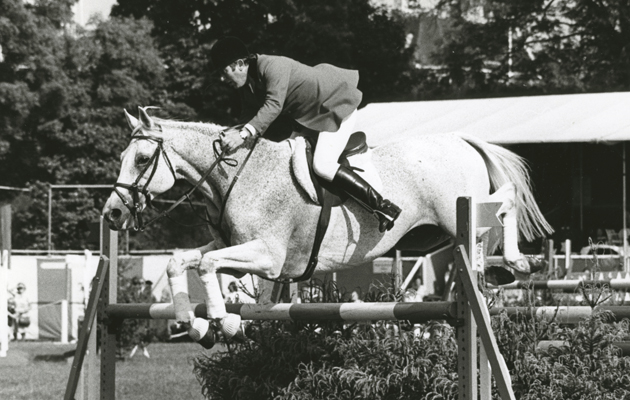Penny Richardson charts the career of the brilliant Irish showjumper and his partnership with quadruple Hickstead Derby winner Boomerang
Ireland is a country full of equestrian myths and legends and among her modern-day tales is that of a man who in the 1970s bestrode the world of international showjumping like a colossus.
Eddie Macken now lives in Canada, on the other side of the Atlantic from his beginnings in a small town in Co. Longford, but he has never been forgotten in his home country. In 2015, a project by 27 schoolchildren, which included his great niece, called for a statue in his honour to be erected in Granard, the place of his birth.
It wasn’t only in Ireland that this unassuming man was a superstar. In 1982, the BBC made a documentary on his partnership with his great horse Boomerang and two years later, he was the subject of ITV’s This is Your Life .
Surprisingly, Eddie doesn’t come from a family of horsemen and he often insists that much of his success was due to being in the right place at the right time.
{"content":"PHA+4oCcV2Ugd2VyZSBmYXJtZXJzIGFuZCBidXRjaGVycywgYnV0IEkgYWx3YXlzIGxvdmVkIGhvcnNlcy4gTGlrZSBtYW55IHNtYWxsIGNoaWxkcmVuIHN0aWxsIGRvLCBJIHByYWN0aXNlZCBvbiB0aGUgYXJtcyBvZiBjaGFpcnMgYW5kIHRoZW4gdGF1Z2h0IG15c2VsZiB0byByaWRlIG9uIHRoZSBwb255IHRoYXQgd29ya2VkIG9uIHRoZSBmYXJtLOKAnSBoZSByZW1lbWJlcnMuPC9wPgo8cD48ZGl2IGNsYXNzPSJhZC1jb250YWluZXIgYWQtY29udGFpbmVyLS1tb2JpbGUiPjxkaXYgaWQ9InBvc3QtaW5saW5lLTIiIGNsYXNzPSJpcGMtYWR2ZXJ0Ij48L2Rpdj48L2Rpdj48c2VjdGlvbiBpZD0iZW1iZWRfY29kZS0zMSIgY2xhc3M9ImhpZGRlbi1tZCBoaWRkZW4tbGcgcy1jb250YWluZXIgc3RpY2t5LWFuY2hvciBoaWRlLXdpZGdldC10aXRsZSB3aWRnZXRfZW1iZWRfY29kZSBwcmVtaXVtX2lubGluZV8yIj48c2VjdGlvbiBjbGFzcz0icy1jb250YWluZXIgbGlzdGluZy0tc2luZ2xlIGxpc3RpbmctLXNpbmdsZS1zaGFyZXRocm91Z2ggaW1hZ2UtYXNwZWN0LWxhbmRzY2FwZSBkZWZhdWx0IHNoYXJldGhyb3VnaC1hZCBzaGFyZXRocm91Z2gtYWQtaGlkZGVuIj4NCiAgPGRpdiBjbGFzcz0icy1jb250YWluZXJfX2lubmVyIj4NCiAgICA8dWw+DQogICAgICA8bGkgaWQ9Im5hdGl2ZS1jb250ZW50LW1vYmlsZSIgY2xhc3M9Imxpc3RpbmctaXRlbSI+DQogICAgICA8L2xpPg0KICAgIDwvdWw+DQogIDwvZGl2Pg0KPC9zZWN0aW9uPjwvc2VjdGlvbj48L3A+CjxwPllvdW5nIEVkZGll4oCZcyBpbnRlcmVzdCBpbiBzaG93anVtcGluZyB3YXMgc2hhcnBlbmVkIGFmdGVyIElyaXNoIHJpZGVyIFNlYW11cyBIYXllcyB3b24gdGhlIGZpcnN0IERlcmJ5IGF0IEhpY2tzdGVhZCBpbiAxOTYxLCBhbmQgZXZlcnkgZGF5IGFmdGVyIHNjaG9vbCBFZGRpZSB3b3VsZCBob25lIGhpcyBza2lsbHMgYXQgdGhlIGxvY2FsIHJpZGluZyBzY2hvb2wgcnVuIGJ5IHZldCBCcmlhbiBHb3JtbGV5IGFuZCBoaXMgd2lmZSBBbm4uPC9wPgo8cD5UaGUgR29ybWxleXMgbXVzdCBoYXZlIHJlY29nbmlzZWQgdGhlIGxhdGVudCB0YWxlbnQgaW4gdGhlaXIgeW91bmcgcHVwaWwsIGFzIGl0IHdhcyB0aHJvdWdoIHRoZW0gdGhhdCBFZGRpZSBnb3QgaGlzIGZpcnN0IGJpZyBicmVhay48L3A+CjxwPuKAnFRoZXkgd2VyZSBmcmllbmRzIG9mIElyaXMgS2VsbGV0dCBhbmQgaW4gMTk2OSB0aGV5IGFycmFuZ2VkIGZvciBtZSB0byBnbyB0byBoZXIgc3RhYmxlcyBpbiBEdWJsaW4gYXMgYSB3b3JraW5nIHN0dWRlbnQs4oCdIGhlIHNheXMuPC9wPgo8ZGl2IGNsYXNzPSJhZC1jb250YWluZXIgYWQtY29udGFpbmVyLS1tb2JpbGUiPjxkaXYgaWQ9InBvc3QtaW5saW5lLTMiIGNsYXNzPSJpcGMtYWR2ZXJ0Ij48L2Rpdj48L2Rpdj4KPHA+VGhpcyB3YXMgYSBodWdlIG9wcG9ydHVuaXR5LCBhcyBJcmlzIHdhcyBoZXJzZWxmIGEgdG9wIGludGVybmF0aW9uYWwgc2hvd2p1bXBlciBhbmQgcmVub3duZWQgdHJhaW5lci4g4oCcRm9yIHRoZSBmaXJzdCBmaXZlIG9yIHNpeCBtb250aHMgSSBuZXZlciBldmVuIHNhdCBvbiBhIGhvcnNlLOKAnSBzYXlzIEVkZGllLiDigJxJbnN0ZWFkLCBJIHdvcmtlZCBvbiB0aGUgeWFyZCBhbmQgbGVhcm50IHRoZSBiYXNpY3MsIG1haW5seSBtdWNraW5nIG91dC4gSSB0aGluayB0aGF04oCZcyBzb21ldGhpbmcgZXZlcnkgeW91bmcgcmlkZXIgc2hvdWxkIGRvLuKAnTwvcD4KPHA+SXQgZGlkbuKAmXQgdGFrZSBsb25nIGZvciBJcmlzIHRvIHJlY29nbmlzZSB0aGF0IHNoZSBoYWQgZm91bmQgYSBkaWFtb25kIGluIDIwLXllYXItb2xkIEVkZGllIGFuZCBqdXN0IHNpeCBtb250aHMgYWZ0ZXIgc2hlIGFsbG93ZWQgaGltIHRvIHN0YXJ0IHJpZGluZyBoZXIgaG9yc2VzLCBoZSB3YXMgb24gaGlzIGZpcnN0IElyaXNoIHRlYW0uIEl0IHdhc27igJl0IGp1c3QgYW55IHRlYW0sIGVpdGhlci4gRWRkaWUgaGFkIGJlZW4gc2VsZWN0ZWQgZm9yIER1YmxpbiBpbiAxOTcwLCB0aGUgTWVjY2EgZm9yIGV2ZXJ5IElyaXNoIHNob3dqdW1wZXIuPC9wPgo8ZGl2IGNsYXNzPSJhZC1jb250YWluZXIgYWQtY29udGFpbmVyLS1tb2JpbGUiPjxkaXYgaWQ9InBvc3QtaW5saW5lLTQiIGNsYXNzPSJpcGMtYWR2ZXJ0Ij48L2Rpdj48L2Rpdj4KPHA+RWRkaWXigJlzIG1vdW50IHdhcyBNb3JuaW5nIExpZ2h0LCB0aGUgaG9yc2UgdGhhdCBoYWQgY2FycmllZCBoaXMgYm9zcyB0byB2aWN0b3J5IGluIHRoZSBsYWRpZXPigJkgRXVyb3BlYW4gQ2hhbXBpb25zaGlwIGF0IHRoZSBzYW1lIHNob3dncm91bmQgdGhlIHByZXZpb3VzIHllYXIsIHNvIHRoZSBwcmVzc3VyZSB0byBwZXJmb3JtIHdlbGwgd2FzIGludGVuc2UuPC9wPgo8cD7igJxJdCB3YXMgYSBiaXQgb2YgYW4gZXhwZXJpZW5jZSzigJ0gc2F5cyBFZGRpZSwgd2l0aCB0eXBpY2FsIHVuZGVyc3RhdGVtZW50LiDigJxJIGRpZG7igJl0IHJlYWxseSBoYXZlIHRpbWUgdG8gYmUgbmVydm91cy4gSSB3YXMgbW9zdGx5IGhvcGluZyB0aGF0IEkgd291bGRu4oCZdCBsZXQgZXZlcnlvbmUgZG93biBieSB0YWtpbmcgdGhlIHdyb25nIGNvdXJzZSHigJ08L3A+CjxkaXYgY2xhc3M9ImFkLWNvbnRhaW5lciBhZC1jb250YWluZXItLW1vYmlsZSI+PGRpdiBpZD0icG9zdC1pbmxpbmUtNSIgY2xhc3M9ImlwYy1hZHZlcnQiPjwvZGl2PjwvZGl2Pgo8cD5IZSBkaWRu4oCZdC4gVGhlIGhvbWUgdGVhbSB3b24gdGhlIDE5NzAgQWdhIEtoYW4gVHJvcGh5IGFuZCBFZGRpZSB3YXMgbm93IElyaXMgS2VsbGV0dOKAmXMgc3RhYmxlIGpvY2tleS48L3A+CjxoMz7igJhUaGUgbW9zdCBiZWF1dGlmdWwgcmlkZXLigJk8L2gzPgo8cD5JdCB3YXMgaW4gdGhhdCBzYW1lIHllYXIgdGhhdCBFZGRpZSBtZXQgdGhlIGhvcnNlIHdobyByZWFsbHkgbWFkZSBoaXMgbmFtZS4gQWZ0ZXIgYmVpbmcgc3RhcnRlZCBieSBoaXMgb3duZXItYnJlZWRlciBKaW1teSBNdXJwaHksIHRoZSB0aG9yb3VnaGJyZWQvSXJpc2ggRHJhdWdodCBnZWxkaW5nIEJvb21lcmFuZyBhcnJpdmVkIGZvciB0cmFpbmluZyBhdCBJcmlz4oCZIGZpbmlzaGluZyBzY2hvb2wuPC9wPgo8cD5FZGRpZSBmaXJzdCByb2RlIGhpbSBhcyBhIGZvdXItIGFuZCBmaXZlLXllYXItb2xkLiDigJxBcyBhIHlvdW5nIGhvcnNlLCBCb29tZXJhbmcgd2FzIHZlcnksIHZlcnkgZGlmZmljdWx0IGluIHRoZSBtb3V0aCwgYnV0IHJlYWxseSBjYXJlZnVsIHRvby4gSGUganVtcGVkIGEgbG90IG9mIGNsZWFyIHJvdW5kcywgYnV0IGhlIGRpZG7igJl0IG1ha2UgdGhlIGJlc3Qgc2hhcGUuIEhpcyBmcm9udCBsZWdzIHdlcmUgYSBiaXQgbG9uZyBhbmQgZGFuZ2x5IGFuZCBsb29raW5nIGJhY2sgb24gaXQsIGl04oCZcyBoYXJkIHRvIHNlZSBob3cgZ29vZCBoZSB3b3VsZCBiZWNvbWUs4oCdIHNheXMgRWRkaWUuPC9wPgo8cD5BdCB0aGUgc3RhcnQgb2YgaGlzIHNpeC15ZWFyLW9sZCBzZWFzb24sIEJvb21lcmFuZyBtb3ZlZCB0byBCcml0YWluIGFmdGVyIGJlaW5nIHNvbGQgdG8gVGVkIEVkZ2FyLCB3aG9zZSB3aWZlIExpeiB0b29rIG92ZXIgdGhlIHJpZGUuPC9wPgo8cD7igJxMaXogd2FzIHRoZSBtb3N0IGJlYXV0aWZ1bCByaWRlci4gU2hlIHB1dCBpbiB0aGUgdGltZSBhbmQgdGhlIGZsYXR3b3JrIHRoYXQgbGFpZCB0aGUgZm91bmRhdGlvbiBmb3IgQm9vbWVyYW5nIHRvIGJlY29tZSB0aGUgaG9yc2UgaGUgZGlkLiBJIG93ZSBoZXIgZXZlcnl0aGluZyzigJ0gc2F5cyBFZGRpZSwgd2hvIGJlY2FtZSBhIGZpcm0gZnJpZW5kIG9mIHRoZSBFZGdhcnMuPC9wPgo8cD7igJxUZWQgd2FzIGFuIGFtYXppbmcgbWFuIHdobyB3YXMgYWhlYWQgb2YgaGlzIHRpbWUuIFdoZW5ldmVyIEkgd2FzIGluIEVuZ2xhbmQsIEkgdXNlZCB0byBnbyB0byBoaW0gZm9yIGZsYXR3b3JrIGhlbHAgYW5kIHdoZW5ldmVyIEkgaGFkIGEgcHJvYmxlbSwgaGUgd2FzIHRoZSBmaXJzdCBwZXJzb24gSeKAmWQgYXNrIGZvciBhZHZpY2Us4oCdIGV4cGxhaW5zIEVkZGllLjwvcD4KPHA+T25lIG9mIEVkZGll4oCZcyBmaXJzdCB0b3AgcmlkZXMgZm9yIElyaXMgS2VsbGV0dCB3YXMgUGVsZS4gTGF0ZXIga25vd24gYXMgS2Vycnlnb2xkIGR1ZSB0byBhIHNwb25zb3JzaGlwIGRlYWwsIFBlbGUgd2FzIHNoYXJlZCBieSBFZGRpZSB3aXRoIGFub3RoZXIgS2VsbGV0dCB0cmFpbmVlLCBQYXVsIERhcnJhZ2gsIHdobyByb2RlIGhpbSB0byB2aWN0b3J5IGluIHRoZSAxOTc1IEhpY2tzdGVhZCBEZXJieS48L3A+CjxwPuKAnFBlbGUgd2FzIGEgbG92ZWx5IGhvcnNlIGFuZCByaWRpbmcgaGltIHdvdWxkIGhhdmUgYmVlbiB0aGUgaGlnaGxpZ2h0IG9mIG1vc3QgcGVvcGxlc+KAmSBjYXJlZXJzLOKAnSBzYXlzIEVkZGllLiDigJxIZSB3YXMgc28ga2luZCBhbmQgd2lsbGluZyB0aGF0IGFueW9uZSB3b3VsZCBoYXZlIGZlbHQgc2FmZSBvbiBoaW0uIEhlIG1pZ2h0IG5vdCBoYXZlIGhhZCB0aGUgZmlnaHQgYW5kIGNhcmVmdWxuZXNzIG9mIEJvb21lcmFuZywgYnV0IGhlIHdhcyBzdGlsbCBhIGZhbnRhc3RpYyBob3JzZS7igJ08L3A+CjxwPlBlbGUgd2FzIEVkZGll4oCZcyBjaG9zZW4gbW91bnQgd2hlbiB0aGUgV29ybGQgQ2hhbXBpb25zaGlwcyB3ZXJlIGhlbGQgYXQgSGlja3N0ZWFkIGluIDE5NzQuIFRoZXkgd2VudCB0aGVyZSBtb3JlIGluIGhvcGUgdGhhbiBleHBlY3RhdGlvbiwgYXMgbmVpdGhlciBob3JzZSBub3IgcmlkZXIgaGFkIG11Y2ggZXhwZXJpZW5jZSBhdCB0aGUgbGV2ZWwuIERlc3BpdGUgdGhpcywgdGhleSBjYW1lIGFnb25pc2luZ2x5IGNsb3NlIHRvIGdsb3J5LCB0YWtpbmcgc2lsdmVyIGFmdGVyIGEganVtcC1vZmYgYWdhaW5zdCBHZXJtYW554oCZcyBIYXJ0d2lnIFN0ZWVua2VuLjwvcD4KPHA+4oCcTG9va2luZyBiYWNrIG9uIGl0LCBJIHdhcyB0b28gaW5ub2NlbnQgYW5kIGRpZG7igJl0IGtub3cgaWYgSSB3YXMgY29taW5nIG9yIGdvaW5nIGJ5IHRoZSBqdW1wLW9mZizigJ0gYWRtaXRzIEVkZGllLjwvcD4KPGgzPuKAmEEgaGFyZCBkZWNpc2lvbuKAmTwvaDM+CjxwPkhvd2V2ZXIsIHRoaXMgcmVzdWx0IHdhcyB0aGUgY2F0YWx5c3QgZm9yIEVkZGll4oCZcyBmaXJzdCBtb3ZlIHRvIEdlcm1hbnkuPC9wPgo8cD7igJxBZnRlciBIaWNrc3RlYWQsIEkgaGFkIGpvYiBvZmZlcnMgZnJvbSBhbGwgb3ZlciB0aGUgd29ybGQuIEl0IHdhcyBhIGhhcmQgZGVjaXNpb24gdG8gbGVhdmUgSXJlbGFuZCwgYnV0IEkgbmVlZGVkIHRvIGdvIHNvbWV3aGVyZSBkaWZmZXJlbnQgaWYgSSB3YW50ZWQgdG8gcmVhbGx5IHN1Y2NlZWQgb24gdGhlIGludGVybmF0aW9uYWwgc3RhZ2UuIFBhdWwgU2Nob2NrZW3DtmhsZSBvZmZlcmVkIG1lIHRoZSBtb3N0IGF0dHJhY3RpdmUgZGVhbCzigJ0gZXhwbGFpbnMgRWRkaWUsIHdob3NlIG5ldyBqb2Igd2FzIHJpZGluZyBmb3IgR2VybWFuIG9pbCBtYWduYXRlIERyIEhlcmJlcnQgU2NobmFwa2EsIG93bmVyIG9mIG1hbnkgaG9yc2VzIGF0IHRoZSBTY2hvY2tlbcO2aGxlIHlhcmQuPC9wPgo8cD5JbiBlYXJseSAxOTc1LCBFZGRpZSBoYWQgdGFrZW4gaGlzIHRoZW4gdG9wIGhvcnNlIEVhc3RlciBQYXJhZGUgdG8gSGlja3N0ZWFk4oCZcyBzcHJpbmcgbWVldGluZyBhbmQgYWZ0ZXIgdGhlIHNob3cgd2FzIGNhbmNlbGxlZCBkdWUgdG8gYmFkIHdlYXRoZXIsIGl0IHdhcyB0aG91Z2h0IHRoYXQgdGhlIGdlbGRpbmcgd291bGQgZW5qb3kgc29tZSB0aW1lIGluIHRoZSBmaWVsZC48L3A+CjxwPuKAnFNvbWV0aGluZyBtdXN0IGhhdmUgc3Bvb2tlZCBoaW0sIGhlIHRyaWVkIHRvIGp1bXAgb3V0IG92ZXIgcG9zdC1hbmQtcmFpbCBmZW5jaW5nLCBtaXNqdWRnZWQgaXQgYW5kIGJyb2tlIGhpcyBiYWNrLOKAnSBzYXlzIEVkZGllLCB3aG8gd2FzIHRoZW4gbGVmdCB3aXRoIG5vIHRvcCByaWRlLjwvcD4KPHA+QnV0IGluIHRoZSB5YXJkIHdhcyBCb29tZXJhbmcsIHRoZW4gUGF1bCBTY2hvY2tlbcO2aGxl4oCZcyBzcGVlZCBob3JzZS4gQWxzbyBvd25lZCBieSBEciBTY2huYXBrYSwgdGhlIGdlbGRpbmcgaGFkIG1hbnkgcmlkZXJzIGluIHRoZSBOZXRoZXJsYW5kcyBhbmQgQmVsZ2l1bSBhZnRlciBiZWluZyBzb2xkIG9uIGJ5IFRlZCBFZGdhci48L3A+CjxwPuKAnFBhdWwgc3VnZ2VzdGVkIHRoYXQgSSByaWRlIEJvb21lcmFuZyB1bnRpbCBJIGZvdW5kIHNvbWV0aGluZyBiZXR0ZXIs4oCdIHNheXMgRWRkaWUuIOKAnEhlIHdhc27igJl0IGEgZ3JlYXQgcHJvc3BlY3QgYXQgdGhlIHRpbWUgYmVjYXVzZSBoZeKAmWQgYmVlbiB0aHJvdWdoIHRoZSBtaWxsIGFuZCB3YXMgc3RvcHBpbmcuIEhl4oCZZCBiZWVuIG11Y2tlZCBhcm91bmQgYW5kIHdhcyBzdGlsbCBhcyBkaWZmaWN1bHQgdG8gcmlkZSBhcyBoZSBoYWQgYmVlbiBhcyBhIHlvdW5nIGhvcnNlLuKAnTwvcD4KPHA+VGhlIGJpZyBicmVha3Rocm91Z2ggY2FtZSB3aGVuIEVkZGllIHRyaWVkIEJvb21lcmFuZyBpbiBhIGJpdGxlc3MgYnJpZGxlLiDigJxIZSB3YXMgYSBkaWZmZXJlbnQgaG9yc2Ugc3RyYWlnaHQgYXdheS4gSGXigJlkIGFsd2F5cyBiZWVuIHZlcnkgYnJhdmUsIGJ1dCBoZeKAmWQganVzdCBiZWNvbWUgY29uZnVzZWQs4oCdIHNheXMgRWRkaWUuPC9wPgo8cD5JdCB0cnVseSB3YXMgYSBtYXRjaCBtYWRlIGluIGhlYXZlbi4gQm9vbWVyYW5nIGlzIG1vc3QgcmVtZW1iZXJlZCBhcyB0aGUgaG9yc2Ugd2hvIHdvbiBmb3VyIGNvbnNlY3V0aXZlIEhpY2tzdGVhZCBEZXJiaWVzLCBidXQgaGUgd2FzIGFjdHVhbGx5IHNvIG11Y2ggbW9yZS4gRnJvbSAxOTc1IHRvIDE5NzksIGhlIGFuZCBFZGRpZSB3b24gMzIgbWFqb3IgZ3JhbmRzIHByaXggYW5kIERlcmJpZXMgYW5kIHJlY29yZCBwcml6ZS1tb25leSBvZiDCozI1MCwwMDAgKGFyb3VuZCDCozEuNW0gdG9kYXkpLiBEciBTY2huYXBrYSBnYXZlIHRoZSBob3JzZSB0byBFZGRpZSBpbiAxOTc3IGFuZCBCb29tZXJhbmcgcmVwYWlkIGhpcyBuZXcgb3duZXIgYnkgaGVscGluZyBoaW0gdG8gdG9wIHRoZSB3b3JsZCByYW5raW5ncyBmb3IgdGhyZWUgY29uc2VjdXRpdmUgeWVhcnMuPC9wPgo8cD5JbiAxOTc4LCBFZGRpZSB0cmF2ZWxsZWQgdG8gQWFjaGVuIGZvciB0aGUgV29ybGQgQ2hhbXBpb25zaGlwcywgZGV0ZXJtaW5lZCB0aGF0IEJvb21lcmFuZyB3b3VsZCBlcmFzZSB0aGUgaGVhcnRhY2hlIG9mIGhpcyBuYXJyb3cgbWlzcyBmb3VyIHllYXJzIGVhcmxpZXIgYXQgSGlja3N0ZWFkLjwvcD4KPHA+4oCcSSBoYWQgbGl2ZWQgd2l0aCB0aGF0IGRlZmVhdCBmb3IgZm91ciB5ZWFycyBhbmQgdm93ZWQgdGhhdCBpdCB3b3VsZCBiZSBkaWZmZXJlbnQgbmV4dCB0aW1lLOKAnSBoZSBzYWlkIGJlZm9yZWhhbmQuPC9wPgo8cD5JdCB3YXNu4oCZdCB0byBiZS4gQm9vbWVyYW5nIG5ldmVyIHRvdWNoZWQgYSBwb2xlIHRocm91Z2hvdXQgdGhlIGNvbXBldGl0aW9uLCBidXQgaW4gdGhlIGZpbmFsIOKAkyB3aGVuIHRoZSBiZXN0IGZvdXIgcmlkZXJzIG92ZXJhbGwgdXNlZCB0byBwYXJ0bmVyIGVhY2ggb3RoZXLigJlzIGhvcnNlcyB0byBkZWNpZGUgdGhlIGNoYW1waW9uIOKAkyBFZGRpZSBtaXNjYWxjdWxhdGVkIHRoZSB0aW1lIG9uIER1dGNobWFuIEpvaGFuIEhlaW5z4oCZIFBhbmR1ciBaLiBIZSBjb2xsZWN0ZWQgYSBxdWFydGVyIG9mIGEgZmF1bHQgYW5kIGFnYWluIGhhZCB0byBiZSBjb250ZW50IHdpdGggdGhlIHNpbHZlciBtZWRhbC48L3A+CjxwPuKAnEl0IHdhcyBhIHN0dXBpZCBtaXN0YWtlIHRoYXQgSSBzaG91bGRu4oCZdCBoYXZlIG1hZGUgYW5kIEkgZmVsdCByZWFsbHkgYmFkIGZvciBteSBob3JzZSwgd2hvIGRlc2VydmVkIHRvIGJlIGNoYW1waW9uLOKAnSBzYXlzIEVkZGllLiDigJxJIGhhdmUgdG8gYWRtaXQgdGhhdCBtaXNzaW5nIG91dCBvbiBpbmRpdmlkdWFsIGdvbGQgZm9yIHRoZSBzZWNvbmQgdGltZSB3YXMgcmVhbGx5IGRpc2FwcG9pbnRpbmcsIGJ1dCB0aGF04oCZcyB0aGUgd2F5IHRoZSBzcG9ydCBnb2VzLiBJIGRpZG7igJl0IGhhdmUgbXVjaCBsdWNrIGluIHRoZSBFdXJvcGVhbiBDaGFtcGlvbnNoaXBzIGVpdGhlciwgYnV0IEkgZGlkIHdpbiBmb3VyIG1lZGFscyBhbHRvZ2V0aGVyLCB3aGljaCBpcyBzb21ldGhpbmcgdG8gYmUgcmVhbGx5IHByb3VkIG9mLuKAnTwvcD4KPHA+QSBmcmFjdHVyZWQgcGVkYWwgYm9uZSBtZWFudCByZXRpcmVtZW50IGZvciBCb29tZXJhbmcgYXQgdGhlIGVhcmx5IGFnZSBvZiAxMyB0byBSYWZlZWhhbiBTdHVkIGluIEtlbGxzLCBDby4gTWVhdGgsIHRoZW4gdGhlIGJhc2Ugb2YgRWRkaWUgYW5kIGhpcyBmaXJzdCB3aWZlIFN1c2FubmUuIFNhZGx5LCB0aGUgc29uIG9mIEJhdHRsZSBCdXJuLCBhbHNvIHRoZSBzaXJlIG9mIEhhcnZleSBTbWl0aOKAmXMgZHVhbCBIaWNrc3RlYWQgRGVyYnkgd2lubmVyIE1hdHRpZSBCcm93biwgZGlkIG5vdCBlbmpveSByZXRpcmVtZW50IGFuZCB3aXRoIGhpcyBmb290IGRldGVyaW9yYXRpbmcsIGhlIHdhcyBwdXQgZG93biBhZnRlciB0aHJlZSB5ZWFycy48L3A+CjxoMz5Ob3QgZm9yZ2V0dGluZyBoaXMgcm9vdHM8L2gzPgo8cD5BZnRlciBCb29tZXJhbmcgYW5kIFBlbGUgcmV0aXJlZCwgRWRkaWUgY29udGludWVkIGluIGludGVybmF0aW9uYWwgY29tcGV0aXRpb24sIGJ1dCB3aXRob3V0IHRoZSByZWFsIHN0YXIgaG9yc2UgdGhhdCB3b3VsZCByZWNhcHR1cmUgdGhvc2UgZ2xvcnkgZGF5cy4gQnkgMTk5NiBoZSB3YXMgYmFjayBpbiBHZXJtYW55LCByaWRpbmcgZm9yIGluZHVzdHJpYWxpc3QgTWljaGFlbCBOaXhkb3JmIGFuZCBhZnRlciBtZWV0aW5nIEthdGhpIEJhbGxlbnRpbmUsIGxhdGVyIHRvIGJlY29tZSBoaXMgc2Vjb25kIHdpZmUsIGhlIG1vdmVkIHRvIENhbmFkYSBpbiB0aGUgZWFybHkgMjAwMHMuPC9wPgo8cD5IZSBhbmQgS2F0aGkgbm93IGxpdmUgYXQgTmV3IEtlbGxzIEZhcm0gaW4gTGFuZ2xleSwgQnJpdGlzaCBDb2x1bWJpYSwgY2xvc2UgdG8gdGhlIFRodW5kZXJiaXJkIGludGVybmF0aW9uYWwgc2hvdyBjZW50cmUuIE5hbWVkIGFmdGVyIEJvb21lcmFuZ+KAmXMgZmluYWwgcmVzdGluZyBwbGFjZSwgS2VsbHMsIENvLiBNZWF0aCwgdGhlIHByb3BlcnR5IGNvbXByaXNlcyAxMCBhY3Jlcywgd2l0aCAyMCBzdGFibGVzIGFuZCBpbmRvb3IgYW5kIG91dGRvb3Igc2Nob29scy48L3A+CjxwPkhvd2V2ZXIsIEVkZGllIGRpZG7igJl0IGZvcmdldCBoaXMgcm9vdHMgYW5kIGNvbnRpbnVlZCByaWRpbmcgZm9yIElyZWxhbmQgdW50aWwgaGlzIGludGVybmF0aW9uYWwgY2FyZWVyIGVuZGVkIGluIDIwMTAuIE9ubHkgdHdvIHllYXJzIGJlZm9yZSB0aGF0LCBoZSB3YXMgYmFjayBhdCBIaWNrc3RlYWQgZm9yIHRoZSBmaXJzdCB0aW1lIGluIGEgZGVjYWRlIGFuZCBmcm9tIHRoZXJlIGhlIHdlbnQgb24gdG8gRHVibGluLCB3aGVyZSBoZSB3YXMgYSBtZW1iZXIgb2YgdGhlIHNlY29uZC1wbGFjZWQgTmF0aW9ucyBDdXAgSXJpc2ggdGVhbS4gSW4gMjAwNCBoZSBoYWQgYmVlbiBhcHBvaW50ZWQgdHJhaW5lciB0byB0aGUgSXJpc2ggdGVhbSBpbiB0aGUgbGVhZC11cCB0byB0aGUgQXRoZW5zIE9seW1waWNzLiBBIGZhbGxpbmcgb3V0IHdpdGggdGhlbiB0ZWFtIG1hbmFnZXIgVG9tbXkgV2FkZSBvdmVyIGJlaW5nIGdpdmVuIG5vIGlucHV0IGludG8gc2VsZWN0aW9uIG1lYW50IHRoYXQgaGUgd2FzIGZpcmVkIGZyb20gdGhlIHVuc2FsYXJpZWQgcG9zaXRpb24sIHRoZW4gcmVpbnN0YXRlZCBmb2xsb3dpbmcgYSByaWRlcnPigJkgc3RyaWtlLjwvcD4KPHA+4oCcRGVzcGl0ZSB3aGF0IGhhcHBlbmVkIHRoZW4sIEkgd291bGQgaGF2ZSBsb3ZlZCB0aGUgY2hhbmNlIHRvIGJlIElyaXNoIGNoZWYgZOKAmcOpcXVpcGUs4oCdIHNheXMgRWRkaWUsIHdobyB0aGVuIGNob3NlIHRvIGNvbmNlbnRyYXRlIG9uIGNvYWNoaW5nIGFuZCBzb3VyY2luZyBob3JzZXMgZm9yIGhpcyBOb3J0aCBBbWVyaWNhbiBjbGllbnRzIHdpdGggdGhlIGhlbHAgb2Ygc29uIFN0ZXZpZS48L3A+CjxwPuKAnFN0ZXZpZSBhbmQgaGlzIGZhbWlseSBsaXZlIGluIEZsb3JpZGEgYW5kIGhlIGNvbW11dGVzIGJldHdlZW4gdGhlcmUsIENhbmFkYSBhbmQgRXVyb3BlLiBIZeKAmXMgdmVyeSBnb29kIGF0IHdoYXQgaGUgZG9lcyBiZWNhdXNlIGhlIGhhcyBhIGdyZWF0IGV5ZSBmb3IgYSBob3JzZSzigJ0gc2F5cyBFZGRpZSwgd2hvc2Ugb3RoZXIgc29uLCBKYW1pZSwgd29ya2VkIGluIFRWIGJlZm9yZSBzdGFydGluZyBoaXMgb3duIHNwb25zb3JzaGlwIGJ1c2luZXNzLjwvcD4KPHA+4oCcSmFtaWUgcm9kZSBhcyBhIGtpZCBhbmQgd2FzIHZlcnkgdGFsZW50ZWQsIGJ1dCBoZSBjaG9zZSBhbm90aGVyIHBhdGguIEhlIGhhcyB0d28gY2hpbGRyZW4gYW5kIGEgbG92ZWx5IGxpZmUgaW4gSXJlbGFuZCzigJ0gc2F5cyBFZGRpZS48L3A+CjxwPkF0IHRoZSBhZ2Ugb2YgNzAsIEVkZGllIHNheXMgdGhhdCBoaXMgcmlkaW5nIGRheXMgYXJlIG5vdyBvdmVyLiDigJxUaGUgbGFzdCB0aW1lIEkgc2F0IG9uIGEgaG9yc2Ugd2FzIGEgeWVhciBhZ28gYW5kIHRvIGJlIGhvbmVzdCwgdGhlIHlvdW5nZXIgZ2VuZXJhdGlvbiBvZiByaWRlcnMgYXJlIG5vdyBzbyBtdWNoIGJldHRlciB0aGFuIG1lLOKAnSBoZSBsYXVnaHMuIOKAnEkgZG9u4oCZdCB3b3JrIGZyb20gaG9tZSBhbnkgbW9yZSwgYnV0IEkgdHJhdmVsIHRvIEZsb3JpZGEgdG8gY29hY2gsIHdoaWNoIGRlbWFuZHMgc28gbXVjaCBvZiBteSB0aW1lLjwvcD4KPHA+4oCcSSBoYXZlIHR3byBtYWluIHB1cGlscywgTWV4aWNv4oCZcyBFdWdlbmlvIEdhcnphIFBlcmV6IGFuZCBBbWVyaWNhbiByaWRlciBFdmUgSm9icy4gVGhleSB3ZXJlIGJvdGggMjAxOSBQYW4gQW0gR2FtZXMgbWVkYWxsaXN0cyBhbmQgY29tcGV0ZSBhdCB0b3AgbGV2ZWwsIHNvIGFsdGhvdWdoIEnigJltIG5vIGxvbmdlciByaWRpbmcgSeKAmW0gc3RpbGwgcGFydCBvZiB0aGUgaW50ZXJuYXRpb25hbCBzY2VuZSwgd2hpY2ggbWFrZXMgbWUgaGFwcHkgYW5kIGtlZXBzIG1lIGludGVyZXN0ZWQu4oCdPC9wPgo8aDM+RWRkaWUgb24gQm9vbWVyYW5nPC9oMz4KPHA+4oCcQm9vbWVyYW5nIHdhcyBhIHVuaXF1ZSBob3JzZSB3aG8gd2FzIGJyaWxsaWFudCBhdCBldmVyeXRoaW5nIGhlIGRpZC4gSGUgd2FzIGV2ZXJ5dGhpbmcgeW91IHdhbnRlZCBoaW0gdG8gYmUgYW5kIGNvdWxkIGp1bXAgYW55dGhpbmcgeW91IGFza2VkLiBJIHRoaW5rIGhl4oCZcyB0aGUgYmVzdCBob3JzZSB0aGVyZeKAmXMgZXZlciBiZWVuIGFuZCBJIHdhcyB2ZXJ5IGx1Y2t5IHRvIHJpZGUgaGltLiBPdXIgZm91cnRoIEhpY2tzdGVhZCBEZXJieSB3aW4gd2FzIHRoZSBtb3N0IHByZWNpb3VzLjwvcD4KPHA+4oCcVGhlIHByZXNzdXJlIHdhcyBvbiB0byBzZXQgYSBob3BlZnVsbHkgdW5iZWF0YWJsZSByZWNvcmQgYW5kIHRoZSBnb2luZyB3YXMgdGhlIHdvcnN0IEnigJlkIGV2ZXIgc2VlbiB0aGVyZS4gT3RoZXIgcmlkZXJzIHdhbnRlZCB0aGUgY291cnNlIG1vZGlmaWVkIGJ1dCBEb3VnaWUgQnVubiwgR29kIHJlc3QgaGltLCB3b3VsZG7igJl0IGhlYXIgb2YgaXQuIEJvb21lcmFuZyB0aGVuIGdhdmUgaGlzIGFsbC7igJ08L3A+CjxoMz5FZGRpZSBvbiBJcmlzIEtlbGxldDwvaDM+CjxwPuKAnEkgZmVlbCB2ZXJ5IGx1Y2t5IHRvIGhhdmUgYmVlbiB0cmFpbmVkIGJ5IElyaXMuIFNoZSB3YXMgdGhlIHF1ZWVuIG9mIElyZWxhbmQgYXQgdGhlIHRpbWUgYW5kIGFsdGhvdWdoIHNoZSBjb3VsZCBiZSBhIGJpdCBpbnRpbWlkYXRpbmcgaWYgeW91IGdvdCB0aGluZ3Mgd3JvbmcsIHNoZSB3YXMgYWN0dWFsbHkgZXh0cmVtZWx5IGtpbmQuPC9wPgo8cD7igJxBcyB3ZWxsIGFzIGJlaW5nIGEgZ3JlYXQgcmlkZXIsIHNoZSB3YXMgYW4gdW5iZWxpZXZhYmxlIGNvYWNoIHdobyBtYWRlIHN1cmUgdGhhdCBJIGhhZCBhbGwgdGhlIGJhc2ljcyByaWdodCBiZWZvcmUgSSBzdGFydGVkIG15IGNhcmVlci7igJ08L3A+CjxoMz5PdXIgc3BvcnTigJlzIGZ1dHVyZTwvaDM+CjxwPuKAnEkgd2FzIHNlbGVjdGVkIGZvciB0aGUgTW9udHJlYWwgT2x5bXBpY3MgaW4gMTk3NiBhbmQgdGhlbiB0b2xkIEkgY291bGRu4oCZdCBnbyBiZWNhdXNlIEkgd2FzIGEgcHJvZmVzc2lvbmFsLiBJIG1pc3NlZCBteSBjaGFuY2UgYmVjYXVzZSBhdCB0aGF0IHRpbWUgQm9vbWVyYW5nIHdhcyBwcm9iYWJseSB0aGUgYmVzdCBob3JzZSBpbiB0aGUgd29ybGQgYW5kIGFsdGhvdWdoIEkgaGFkIG5pY2UgaG9yc2VzIHdoZW4gSSBkaWQgbWFrZSBpdCBpbiAxOTkyIGFuZCAxOTk2LCB0aGV5IHdlcmVu4oCZdCBzdXBlcnN0YXJzLjwvcD4KPHA+4oCcSSBkbyB0aGluayBlcXVlc3RyaWFuIHNwb3J0cyBzdGlsbCBoYXZlIGEgcGxhY2UgaW4gdGhlIE9seW1waWNzIGFuZCBhbHRob3VnaCBtYW55IHBlb3BsZSBkb27igJl0IGxpa2UgdGhlIGNoYW5nZSB0byB0aHJlZS1tYW4gdGVhbXMsIGl0IGhhZCB0byBiZSBkb25lIGFuZCB3YXMgcHJvYmFibHkgdGhlIHJpZ2h0IHRoaW5nLjwvcD4KPHA+4oCcSXTigJlzIGVhc3kgdG8gdGhpbmsgb2YgdGhlIGdvb2Qgb2xkIGRheXMgYW5kIEnigJltIGEgdHJhZGl0aW9uYWxpc3Qgd2hvIGxvdmVzIHRoZSBiaWcgZ3Jhc3MgYXJlbmFzIGF0IEhpY2tzdGVhZCwgRHVibGluIGFuZCBBYWNoZW4sIGJ1dCBzcG9ydCBoYXMgdG8gbW92ZSB3aXRoIHRoZSB0aW1lcyBhbmQgYXQgbGVhc3QgdmVudHVyZXMgc3VjaCBhcyB0aGUgR2xvYmFsIENoYW1waW9ucyBUb3VyIFtHQ1RdIGFuZCBMZWFndWUgZ2l2ZSB0YWxlbnRlZCByaWRlcnMgdGhlIGNoYW5jZSB0byBlYXJuIGEgcmVhbCBsaXZpbmcuIEFsdGhvdWdoIHRoZSBHQ1QgaXMgYSBnb29kIHRoaW5nLCBJIHRlbGwgdGhlIHJpZGVycyBJIHRyYWluIHRoYXQgdGhleSBzaG91bGQgZ2V0IGdyYW5kcyBwcml4IGFuZCBob3BlZnVsbHkgdGVhbSBhcHBlYXJhbmNlcyB1bmRlciB0aGVpciBiZWx0IGJlZm9yZSBkb2luZyB0aG9zZSBzaG93cy48L3A+CjxwPuKAnEFub3RoZXIgcmVzZXJ2YXRpb24gaXMgdGhlIGNvc3Qgb2YgaXQgYWxsLiBNb2Rlcm4gc2hvd2p1bXBpbmcgaXMgYSB2ZXJ5IGRlbWFuZGluZyBzcG9ydCBhbmQgaG9yc2VzIGNvc3Qgc28gbXVjaCB0aGVzZSBkYXlzLiBUbyBiZSBmYWlyLCBpdOKAmXMgYWxsIHJlbGF0aXZlLiBJbiBteSBkYXksIHdlIHRob3VnaHQgaXQgd2FzIGdyZWF0IGlmIGEgZ3JhbmQgcHJpeCB3YXMgd29ydGggwqMxLDUwMCB0byB0aGUgd2lubmVyLCBidXQgYSBnb29kIGhvcnNlIHN0aWxsIGNvc3RlZCB1cyBhcyBtdWNoIGFzIGEgaG91c2Ugd291bGQgaGF2ZSBkb25lIHRvIGJ1eSHigJ08L3A+CjxoMz5UaGUgZ3JlYXRlc3QgZmVlbGluZzwvaDM+CjxwPk9ubHkgaW4gSXJlbGFuZCB3b3VsZCBtYWpvciByb2FkcyBpbiB0aGUgY2FwaXRhbCBiZSBjbG9zZWQgZm9yIGEgaG9yc2Ugc2hvdyBhbmQgbW9zdCBvZiB0aGUgY291bnRyeSBzZXR0bGUgZG93biB0byB3YXRjaCB0aGUgTmF0aW9ucyBDdXAgb24gcHJpbWUgdGltZSBUVi48L3A+CjxwPuKAnFdoZW4gSSBtYWRlIG15IGZpbmFsIGFwcGVhcmFuY2UgaW4gRHVibGluIGluIDIwMDgsIEkgY2Fu4oCZdCByZW1lbWJlciB3aGV0aGVyIEkgaGFkIGJlZW4gb24gdGhlIElyaXNoIHRlYW0gdGhlcmUgMjcgb3IgMjggdGltZXMsIGJ1dCB0aGUgZmVlbGluZyBvZiBwcmlkZSBuZXZlciB3ZW50IGF3YXkuIEV2ZXJ5IHRpbWUgeW91IGdldCB0aGUgY2hhbmNlIHRvIHRyeSB0byB3aW4gdGhlIEFnYSBLaGFuIFRyb3BoeSBmb3IgeW91ciBuYXRpb24sIGl04oCZcyBsaWtlIGEgZHJlYW0gY29tZSB0cnVlLiBJdOKAmXMgdGhlIGhpZ2hsaWdodCBvZiBldmVyeSBJcmlzaCByaWRlcuKAmXMgY2FyZWVyIGFuZCBhbHdheXMgc2hvdWxkIGJlLuKAnTwvcD4KPGgzPlJlbWVtYmVyZWQgZm9yZXZlcjwvaDM+CjxwPkFmdGVyIEJvb21lcmFuZ+KAmXMgZGVhdGgsIGhlIHdhcyBidXJpZWQgYXQgUmFmZWVoYW4gU3R1ZCBpbiBhIGdyYXZlIHN1cnJvdW5kZWQgYnkgZm91ciBldmVyZ3JlZW4gdHJlZXMuIFRoaXMgc3ltYm9saXNlZCB0aGlzIHJlbWFya2FibGUgaG9yc2XigJlzIGZvdXIgY29uc2VjdXRpdmUgSGlja3N0ZWFkIERlcmJ5IHRyaXVtcGhzLCBmb3VyIGNsZWFyIHJvdW5kcyBpbiB0aGUgZmluYWwgb2YgdGhlIDE5NzggV29ybGQgQ2hhbXBpb25zaGlwLCBmb3VyIGRvdWJsZSBjbGVhcnMgaW4gYSByb3cgaW4gTmF0aW9ucyBDdXBzIGF0IER1YmxpbiBhbmQgZm91ciBIb3JzZSBvZiB0aGUgWWVhciBTaG93IGdyYW5kIHByaXggd2lucy48L3A+CjxwPkl0IGlzIHRoZSBsYXR0ZXIgZmVhdCB0aGF0IEVkZGllIGNvbnNpZGVycyB0aGVpciBncmVhdGVzdC4g4oCcQXQgdGhlIHRpbWUsIHRoZSBzaG93IGF0IFdlbWJsZXkgd2FzIHRoZSBiZXN0IGluIEV1cm9wZSBhbmQgdG8gd2luIGEgY2xhc3MgdGhlcmUgd2FzIGEgaHVnZSBhY2hpZXZlbWVudC4gV2hlbiBCb29tZXJhbmcgd29uIHRoZSBncmFuZCBwcml4IHRocmVlIHllYXJzIGluIGEgcm93LCBpdCB3YXMgYW1hemluZy48L3A+CjxkaXYgY2xhc3M9ImluamVjdGlvbiI+PC9kaXY+CjxwPuKAnEhlIHNob3VsZCBoYXZlIG1hZGUgaXQgZm91ciB0aGUgbmV4dCB5ZWFyLCBidXQgd2UgaGFkIHRoZSBsYXN0IGZlbmNlIGRvd24gaW4gdGhlIGZhc3Rlc3QgdGltZS4gVGhlbiB3ZSBjYW1lIGJhY2sgYW5kIHdvbiBpdCBhZ2Fpbi4gVGhvc2UgZm91ciB3aW5zIGF0IFdlbWJsZXkgd2VyZSBkZWZpbml0ZWx5IHRoZSBoaWdobGlnaHRzIG9mIG15IGNhcmVlci7igJ08L3A+CjxoMz5FZGRpZSBNYWNrZW4gaW4gbnVtYmVyczwvaDM+CjxwPjQgY29uc2VjdXRpdmUgSGlja3N0ZWFkIERlcmJ5IHRyaXVtcGhzPC9wPgo8cD7CozI1MCwwMDAgQm9vbWVyYW5n4oCZcyByZWNvcmQgcHJpemUgbW9uZXk8L3A+CjxwPjMgY29uc2VjdXRpdmUgQWdhIEtoYW4gQ3VwIHdpbnMgd2l0aCB0aGUgSXJpc2ggdGVhbTwvcD4KPHA+NCBIb3JzZSBvZiB0aGUgWWVhciBTaG93IGdyYW5kIHByaXggd2luczwvcD4KPHA+MiBpbmRpdmlkdWFsIHNpbHZlciB3b3JsZCBtZWRhbHM8L3A+CjxwPjxlbT5SZWYgSG9yc2UgJmFtcDsgSG91bmQ7IDI1IEp1bmUgMjAyMDwvZW0+PC9wPgo8cD4K"}
You may also be interested in…
As we approach the 50th anniversary of the Hickstead Derby, 1966 winner David Broome shares his memories of the class
Showjumping has changed and evolved in the 54 years since the All England Jumping Course first opened its doors —
From his early days on a dairy farm to the giddy heights of the Olympics, David Broome is one of
The teenage girl on a pony that conquered the world stage has become the stuff of showjumping legend. Penny Richardson
Credit: Trevor Meeks





